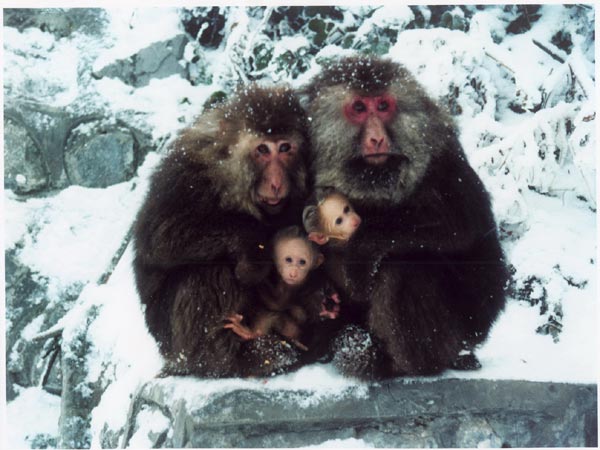
Monkeys on Mount Emei are notorious for snatching food from tourists, but many people still find them cute enough to offer food.[Photo by Wu Jian / For China Daily]
Monkeys on Mount Emei are also known to have robbed tourists of their food. That's why locals often advise visitors to show their empty palms to the simians to avoid being attacked. But most tourists prefer to offer food to the lively creatures.
Emei is a poetic term for "beautiful women" in Chinese. Spread over 154 square kilometers, Mount Emei, included in the UNESCO World Natural and Cultural Heritage List in 1996, offers a panoramic view of the landscape throughout the year. In spring, its azaleas are brilliantly red. In summer, its lush green trees and grass give it a verdant look. In autumn, the mountain is a riot of colors, the green, yellow, orange and red of the trees mingling with the blue of the sky. And in winter, the mountain becomes a white wonderland, with the ancient temples, trees and mountain slopes covered in snow.
"Snow usually lasts until April," says Wang Yu, a visitor. But since winter offers more clear days, it is the best season to see the "Buddha's Halo", the mountain's most celebrated natural phenomenon.
But only the lucky few can see the "Buddha's Halo" (rainbow-like rings that surround and move with your shadow) against the background of the Golden Summit which is 3,077 meters above the sea level. It is said that in the past, devoted Buddhists assumed the phenomenon was a call from beyond and jumped off the Cliff of Self-Sacrifice on the Golden Summit.
Believers may no longer be jumping off the cliff at the sight of the "halo", but even non-believers consider it a blessing to see one.
Be informed, though, that despite travel guides claiming that one can see all the four wonders — "Buddha's Halo", Sea of Clouds, the Holy Lamp (or Divine Lights) and the Golden Summit Sunrise — during a single visit to Emei, it is rarely possible. But even if you witness one or two of the four, consider your trip a grand success.
And since no tour is complete without food, don't forget to enjoy a meal of bamboo shoots, bean curd and vegetables on Emei. Food on Emei is a vegetarian affair.
But "for 30 yuan ($4.80), one can eat 'fish' made from potatoes and 'meat' made from wax gourd in the temples, including Wannian," says Liu Jinghua, a waiter in the vegetarian restaurant in a Wannian Temple.
